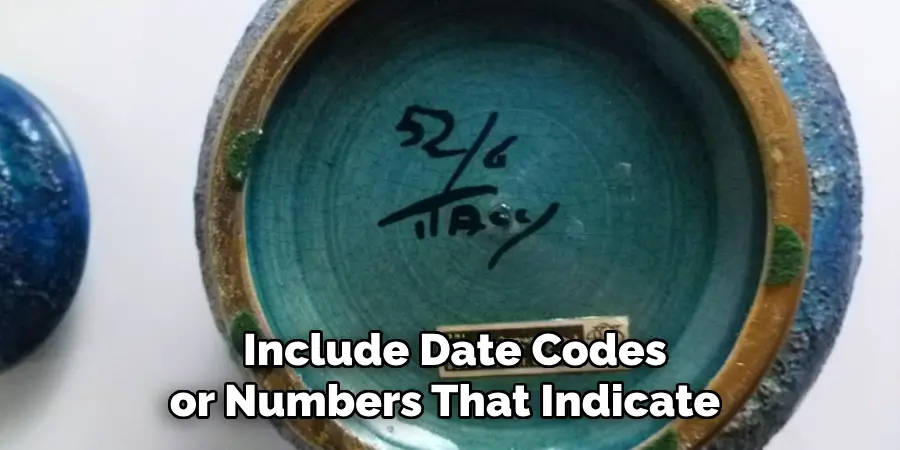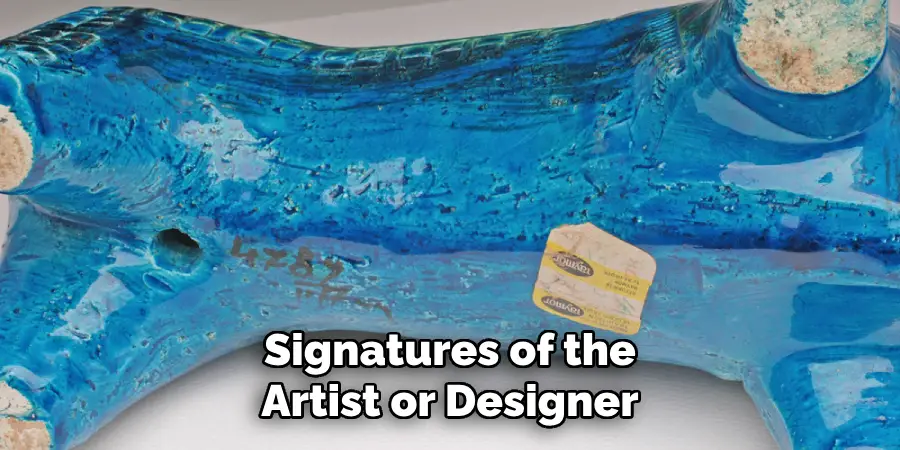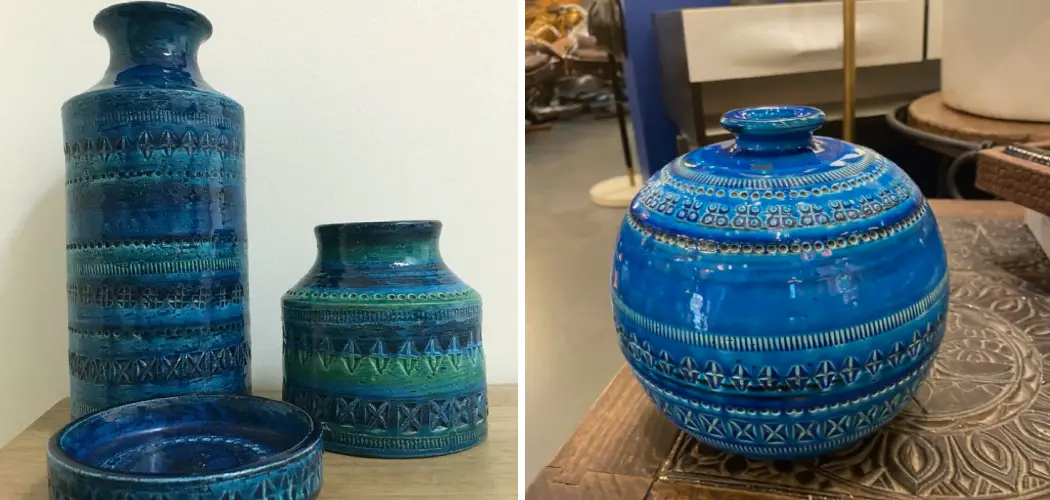Are you a collector of pottery, specifically Bitossi ceramics from Italy? If so, you know that there are some unique characteristics that make them easily recognizable. From the distinctive glazes used by its founder to the colorful designs characteristic of this type of Italian pottery, learning how to properly identify these pieces can be invaluable for both collecting and selling.

In this blog post on how to identify bitossi pottery we will explore the history behind Bitossi Pottery and present an in-depth guide on identifying various styles and materials associated with it. So if you’re looking to become an expert when it comes to inspecting your favorite Italian ceramic works, then read on!
Why Identify Bitossi Pottery?
Bitossi Pottery is highly sought after by collectors due to its history and unique aesthetic. Founded in 1921 by Guido Bitossi in Montelupo Fiorentino, Italy, this ceramic company has produced a variety of pieces over the years, ranging from tableware to decorative objects. In addition, many famous designers have worked with Bitossi Pottery, creating limited-edition and one-of-a-kind pieces that are highly coveted.
As a result, being able to identify Bitossi Pottery can help you determine the value of a piece and potentially make a smart investment. It can also prevent you from unknowingly purchasing fake or imitation pieces, as they can often be mistaken for the real thing.
10 Step-by-step Instructions on How to Identify Bitossi Pottery
Step 1: Look for the Mitosis Stamp
Most Bitossi Pottery pieces are stamped with a variation of the company’s name, such as “Bitossi” or “Made in Italy.” This stamp is usually located on the bottom of the piece and can help you confirm its authenticity. It is important to note that early pieces may not have a stamp, so this method may not always be effective. But for more recent pieces, this is a good first step in identifying Bitossi Pottery.
Step 2: Pay Attention to the Glaze
Bitossi Pottery is known for its unique glazes that often have a metallic or iridescent finish. These glazes are usually very thick and may include multiple layers of color.

This can make it stand out from other types of pottery, so pay attention to the glaze when identifying Bitossi. You can also use this as a way to compare pieces, as each glaze is unique and can help you determine if a piece is authentic.
Step 3: Take Note of the Colors Used
Bitossi Pottery often features bright colors, such as blues, greens, yellows, and oranges. These colors are used in bold patterns and designs that are typical of Italian ceramics. In addition, Bitossi Pottery is known for its use of gold and metallic accents, which can give pieces a luxurious and eye-catching look. This color palette is a key characteristic to look for when identifying Bitossi Pottery.
Step 4: Familiarize Yourself with Different Shapes and Forms
Bitossi Pottery pieces come in a variety of shapes and forms, ranging from traditional vases and bowls to more unique designs like animal figurines and abstract sculptures. Knowing the different styles produced by Bitossi over the years can help you identify a piece with more accuracy. Some of the most popular shapes include cylindrical vases, bulbous vases, and ceramic plates.
Step 5: Look for Hand-painted Details
Many Bitossi Pottery pieces are hand-painted, which adds an extra element of uniqueness to each piece. These details may be found in intricate designs and patterns or in the use of gold accents.

Pay attention to these hand-painted details when identifying Bitossi Pottery, as they can help confirm its authenticity. It is also worth noting that not all pieces are hand-painted, as some may have been mass-produced.
Step 6: Check for Signatures
In addition to the Mitosis stamp, many Bitossi Pottery pieces may also have the artist’s signature. This can often be found on the bottom of the piece, along with the company stamp.
These signatures are usually in pencil or glaze and may include the designer’s name or initials. Familiarizing yourself with these signatures can help you identify a specific artist’s work, making it easier to determine the value of a piece. You can also research the artist’s signature online to find out more information about their work.
Step 7: Examine the Material Used
Bitossi Pottery is typically made from high-quality materials, such as red clay or white stoneware. These materials are durable and often have a smooth finish. If you notice any cracks or chips in the material, it may be a sign that the piece is not authentic or has been damaged. In addition, some Bitossi Pottery pieces may have a matte finish, so pay attention to the texture of the material when identifying.
Step 8: Look for Specific Markings
While most Bitossi Pottery pieces are stamped with the company’s name and signature, there may also be other markings to look out for. These can include date codes or numbers that indicate when the piece was made, as well as production numbers that may be unique to a specific design. Familiarizing yourself with these markings can help you determine the rarity of a piece and its estimated value.

Step 9: Do Your Research
One of the best ways to become an expert at identifying Bitossi Pottery is to do your research. This can include studying different styles and designs, as well as reading up on the history of the company and its artists. You can also attend pottery exhibitions or talk to other collectors to gain more knowledge about Bitossi Pottery.
Step 10: Consult with Experts
If you are still unsure about a piece, it is always best to consult with an expert. There are many online forums and groups dedicated to Bitossi Pottery, where you can ask for help in identifying a specific piece. You can also visit antique shops or auctions and speak with knowledgeable staff members who can provide more information about Bitossi Pottery.
Always be cautious and do your research before making a purchase to ensure you are buying an authentic piece of Bitossi Pottery. With these steps on how to identify bitossi pottery in mind, you can become an expert at identifying Bitossi Pottery and add unique pieces to your collection.
Additional Tips
- Don’t Be Afraid to Ask for More Photos or Information When Purchasing Bitossi Pottery Online. This Can Help You Verify the Authenticity of a Piece.
- Keep an Eye Out for Pieces That May Have Been Damaged and Repaired, as This Can Affect Its Value.
- Be Wary of Incredibly Low Prices, as They Could Indicate a Fake or Imitation Piece.
- If a Piece is Not in Good Condition, It is Best to Leave It as Restoring Bitossi Pottery Can Be Difficult and May Decrease Its Value.
- Trust Your Instincts and Use All of the Information You Have Gathered to Make an Informed Decision When Identifying Bitossi Pottery.
- Remember That Identifying Bitossi Pottery is an Ongoing Learning Process and You May Come Across Pieces That Challenge Your Knowledge.
Frequently Asked Questions
Q1: How Can I Tell if a Piece is Authentic Bitossi Pottery?
A1: Look for the Mitosis stamp, unique glaze and color combinations, hand-painted details, signatures of the artist or designer, and specific markings such as date codes or production numbers. It is also important to research different styles and designs, as well as consult with experts.

Q2: Are All Bitossi Pottery Pieces Hand-Painted?
A2: No, not all pieces are hand-painted. Some may have been mass-produced and lack the intricate hand-painted details. However, hand-painting is a common characteristic of Bitossi Pottery and should be considered when identifying a piece.
Q3: Can I Find Bitossi Pottery Outside of Italy?
A3: Yes, Bitossi Pottery is exported and can be found in antique shops, auctions, and online. However, it is important to be cautious and do your research when purchasing pieces from outside of Italy to ensure they are authentic. So, always try to buy from a trusted dealer or consult with experts before making a purchase.
Q4: What is the Best Way to Learn About Bitossi Pottery?
A4: Research, research, research! Familiarize yourself with different styles and designs, read up on the history of the company and its artists, attend exhibitions or pottery fairs, talk to other collectors, and consult with experts.
These steps can help you become an expert at identifying Bitossi Pottery and expand your knowledge about this unique form of Italian ceramics.
So, happy learning and collecting! Keep exploring the world of Bitossi Pottery, and you may discover rare and valuable pieces along the way. So, start your journey today!
Conclusion
In conclusion on how to identify bitossi pottery, you can easily identify Bitossi pottery by its use of vibrant colors, markers like numbers and stamps on the bottom, blue and orange deer, and unique geometric shapes. By honing in on these signature aesthetics, you’ll soon become a pro at recognizing this desired type of ceramics.
To keep improving your knowledge and stay informed about the Bitossi Pottery legacy, join our mailing list or follow us on social media outlets like Instagram or Facebook. Don’t hesitate to reach out with any questions you may have—we’d love to hear from you! Thanks for reading along and digging deeper into this craftsmanship style.


